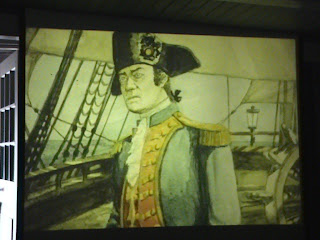 John Paul Jones
John Paul JonesI am sure not may people will know that they would have to travel to Scotland to find the Founder or Father of the American Navy, John Paul Jones. Today I was driving along the Solway coast and decided to stop at his birthplace, a tiny, two roomed cottage on the Arbigland Estate, where his father was the gardener.
Such humble beginnnings are hard to believe, but it goes to show that in life, if you are determined, you will succeed. John Paul was born on the 6th July 1747 (the name Jones was added later in life) and went to the local school at Kirkbean. He liked to go to the local small port of Carsethorn, where he enjoyed meeting and talking to the sailors. Along with his friends he would act out naval battles, with John Paul in command giving the orders. At 13 he signed up for a naval apprenticeship, and set sail for real, this time from Carsethorn. One of his voyages took him to America where his older brother had emigrated. He stayed with him at Fredericksburg, Virginia, and studied navigation.
The tiny cottage in S W Scotland where he was born.
Bedroom of the Cottage
Main room of the cottage
By the age of 21 he was a Captain, always neatly dressed, and standing no nonsense from anyone! despite being only 5'5" tall. He was to travel to Scotland many times, in the course of his work.
By the age of 21 he was a Captain, always neatly dressed, and standing no nonsense from anyone! despite being only 5'5" tall. He was to travel to Scotland many times, in the course of his work.
Commodore Jones stood no nonsense from the crew!!
Always of smart appearance.
When the American War of Independence came, he supported the colonists, which did not make him very popular back in UK. He joined the American "Continental Navy" in 1775. His reputation and experience became such that he was asked to advise on the drawing up of Navy Regulations. In 1777 with his friend Benjamin Franklin, he forced the French to salute the American Flag at Quiberon. This was the first time the American Flag had been hoisted in a foreign port.
After this he went to Whitehaven on the English side of the Solway for a hit and run raid after which he would travel to Scotland again, to Kirkcubright Bay, where his crew did a spot of looting, before going on to a naval battle at Carrickfergus, which he won. The British were not happy, and were really out to get him now! He did not have good press in Britain and was regarded as a pirate.
Next he went to Brest, where he took command of his most famous ship, the Bonhomme Richard. From here he was to travel to Scotland with a fleet of seven ships on a mission to destroy British trade in the North Sea. After some adventures in the Firth of Forth he was to engage in his most famous naval battle against the HMS Serapis, and the HMS Countess of Scarborough, which he won, with the loss of the Bonhomme Richard. The year was 1779.
Replica of the Bonhomme Richard
Two years later he returned to America where he spent his time advising on the establishment of the American Navy, and training naval officers.
By 1788 he was in Paris and on the recommendation of Thomas Jefferson, he met Catherine, Empress of Russia, and was made an Admiral in the Russian Navy before returning to Paris in 1790. He died at the age of 45 in Paris two years later, where his remains lay until 1905.
President Roosevelt, ordered that his remains be found, and transported to the USA. Amidst great ceremony, John Paul Jones returned to Chesapeake Bay to be met by seven battleships, and 15 gun salutes. He was then taken to Annapolis,to be laid to rest in huge marble tomb in the Crypt of the Chapel of Annnapolis Naval Academy.
So, the young boy from the tiny gardener's cottage did not travel to Scotland again. His final resting place is a testament to the esteem in which he is held in America.
Scottish and American flags fly in the garden of the John Paul Jones Museum.









































